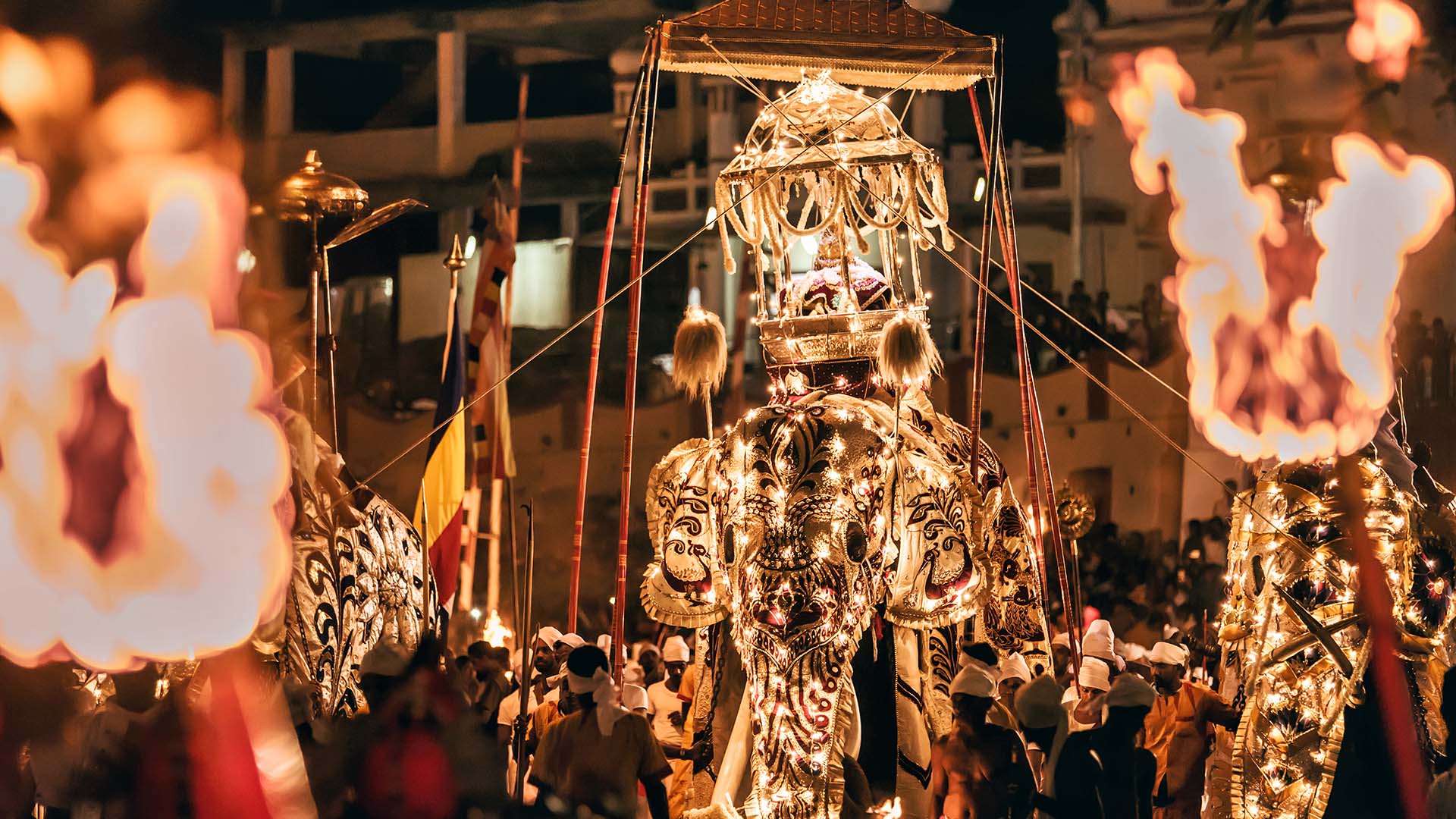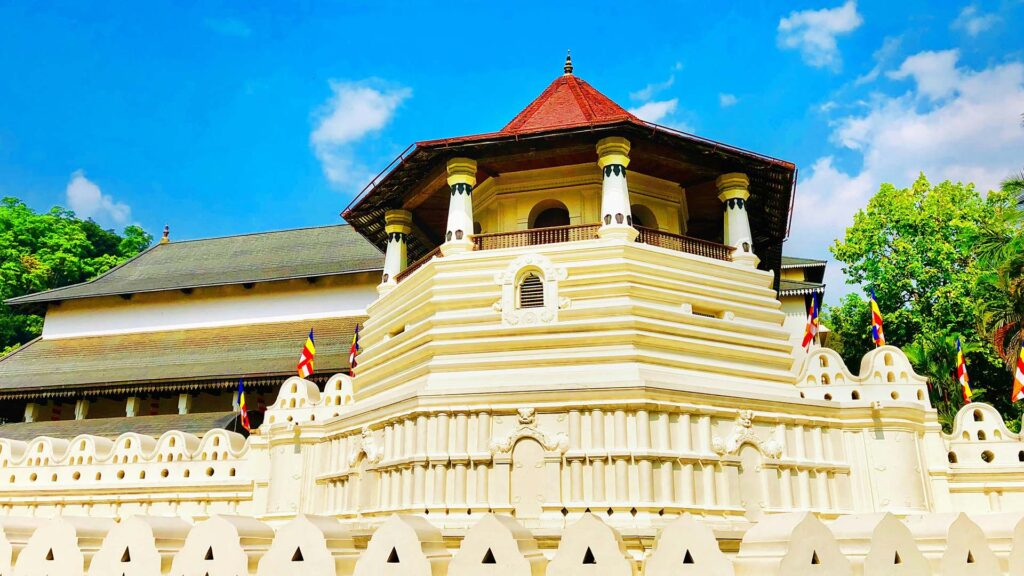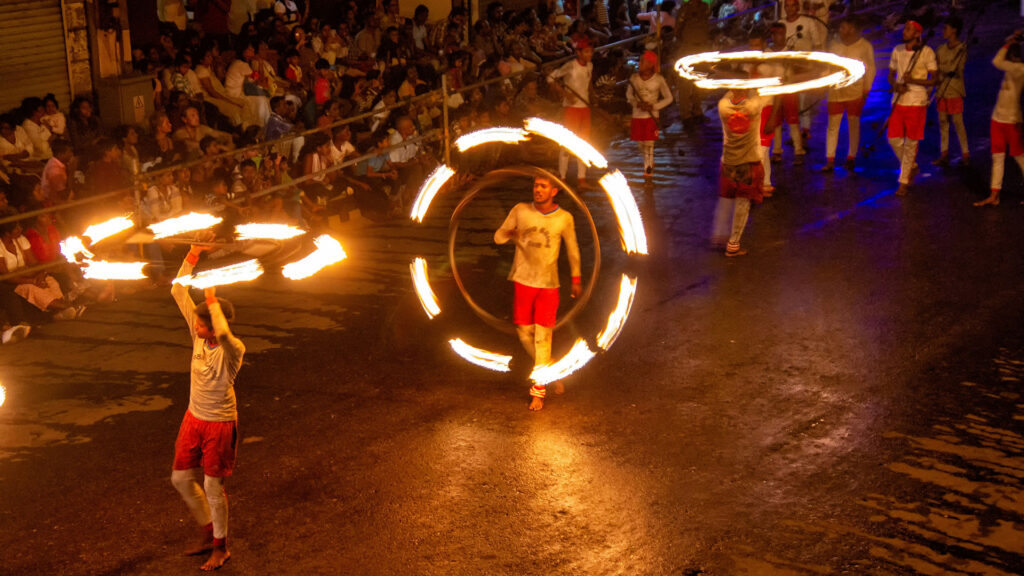
The majestic tusker in Sri Lanka’s Esala Perahera / Credit: Sachin Fernando
Every year, the streets of Kandy, Sri Lanka, come alive with a vibrant tapestry of colour, tradition, and spiritual fervour during the Kandy Esala Perahera. Rooted in centuries-old customs, this grand procession celebrates the sacred Tooth Relic of Buddha and is a testament to the island’s rich cultural and religious heritage. From its fascinating origins to its present-day spectacle, the Perahera remains a profound symbol of Sri Lanka’s deep historical and spiritual connections.
Historical Background
The Kandy Esala Perahera is a festival that honours the sacred Tooth Relic of Lord Buddha, revered for its deep spiritual and historical significance as both a religious icon and symbol of sovereignty. Originating in the 3rd century BCE, it began as a Hindu ritual for rain and later evolved into a grand Buddhist festival held over ten days in July and August. Recognized by UNESCO for its cultural heritage, the Esala Perahera has grown in both size and importance, blending religious devotion with cultural exuberance and attracting visitors from around the world with its enduring appeal.
Origins of the Sacred Tooth Relic
The Sacred Tooth Relic, believed to be a tooth of Lord Buddha, was brought to Sri Lanka from India in the 4th century CE by Princess Hemamali and Prince Dantha, who smuggled it hidden in her hair to protect it from political unrest. Originally housed in Anuradhapura, the ancient capital, the relic was moved several times for safety during periods of instability before finally being enshrined in the Temple of the Sacred Tooth Relic (Sri Dalada Maligawa) in Kandy during the 16th century under King Vimaladharmasuriya I. Possession of the relic became a powerful symbol of divine right and legitimacy for Sri Lankan kings and remains central to Kandy’s religious and cultural heritage today.

Sri Dalada Maligawa: The Temple of the Sacred Tooth Relic / Credit: Supun Batagoda
Religious and Cultural Significance of the Perahera
The Kandy Esala Perahera, celebrated annually during the Esala month, holds profound religious significance for Buddhists, providing an opportunity to honour the Sacred Tooth Relic—a revered symbol of Lord Buddha. Originally rooted in Sri Lanka’s agrarian society as a rain-invoking ritual, the festival has evolved to blend spiritual observance with the cycles of nature, illustrating the interconnectedness of life and spirituality in Sri Lankan culture. Serving as a platform for devotees to seek blessings for prosperity and peace, it merges Buddhist practices with indigenous customs and showcases the country’s rich cultural heritage. The festival culminates in the Maha Randoli Perahera, a magnificent procession of lavishly decorated elephants, dancers, acrobats, and vibrant drumming and flames, offering an immersive experience of Sri Lanka’s artistry, tradition, and fervent religious devotion.
Globally, the Kandy Esala Perahera is regarded as one of Sri Lanka’s most spectacular cultural celebrations. It attracts visitors from around the world, boosting its international reputation. As a UNESCO World Heritage Site, Kandy’s association with the festival further elevates its global profile. Renowned for its vibrant cultural pageantry, the festival is an unrivaled spectacle. The grand processions make it a significant event, recognized both religiously and culturally worldwide.

Fire dancers at Esala Maha Perahera, Kandy, Sri Lanka / Credit: Yves Alarie
Traditional Elements of the Festival
During the Kandy Esala Perahera, elephants serve as majestic symbols, lavishly adorned in silk costumes and fairy lights. These grand creatures, especially the esteemed Maligawa Tusker, capture attention as they stride through the procession, bearing the golden casket that symbolizes the Sacred Tooth Relic. As the highlight of the festival, the Maligawa Tusker enhances the event’s spiritual significance. Ornately decorated elephants march alongside musicians, dancers, and torchbearers, creating a mystical aura that captivates onlookers.
Traditional Dancers
Cultural dances bring the Kandy Esala Perahera to life, showcasing Sri Lanka’s rich artistic heritage. Men and women perform together, reflecting the nation’s cultural diversity and inclusivity. Their energetic movements add dynamic rhythm to the parade, creating a captivating spectacle. Kandyan dancers, central to the procession, delight the audience with their vibrant performances. Alongside drummers and fire performers, they exemplify the artistic excellence celebrated at the festival. These traditional dances are more than rhythmic displays—they are expressions of cultural pride and artistry, cherished by both locals and visitors. The colourful costumes and synchronized choreography make these dances the highlight of this grand festival.
The Spectacular Climax: Randoli Perahera’s Grand Finale
The Kandy Esala Perahera is a spectacle like no other. Known for its vibrant processions, the festival blends ancient traditions with spiritual reverence. Each night, the festivities grow more elaborate, culminating in the Randoli Perahera—a grand finale featuring spectacular performances and rituals that create an unforgettable celebration. The event also includes significant processions such as the Kumbal Perahera, each highlighting unique cultural and spiritual elements.
The Water Cutting Ceremony
The Water Cutting Ceremony, known as Diya Kapeema, marks the conclusion of the Kandy Esala Perahera at the Mahaweli River. This ritual embodies purification and renewal for the city and its people. Through this ceremony, blessings are invoked for rain in the coming seasons, ensuring prosperity for agriculture. Diya Kapeema represents symbolic cleansing and the preservation of enduring traditions. It encapsulates the festival’s spiritual essence, emphasizing continuity and devotion. As a closing act, it reinforces the festival’s role in uniting the community and culture in a lasting celebration.
Visiting Tips for Tourists
If you plan to visit Kandy for the Esala Perahera in 2025, book your accommodation in advance, as hotels fill up quickly, especially near the city centre. Families eagerly anticipate the festivities set against Kandy’s misty mountains and the scenic Kandy Lake. Arrive early to secure a good spot, as both tourists and locals gather from morning, particularly near the Temple of the Tooth Relic and the Queens Hotel. Reserve seats through local agencies for the best views.
Remember to dress modestly by covering your shoulders and knees to respect the festival’s religious significance, and be prepared to remove your shoes when entering temple grounds. Bring water, snacks, and an umbrella or fan, as processions can last several hours and shops may be difficult to access once crowds gather.
Find event dates and route details on the Kandy Esala Perahera Festival 2025 website. For a personalized trip, contact a destination management company that specializes in Sri Lanka. To learn more about everything the country has to offer, contact Sri Lanka Tourism.
